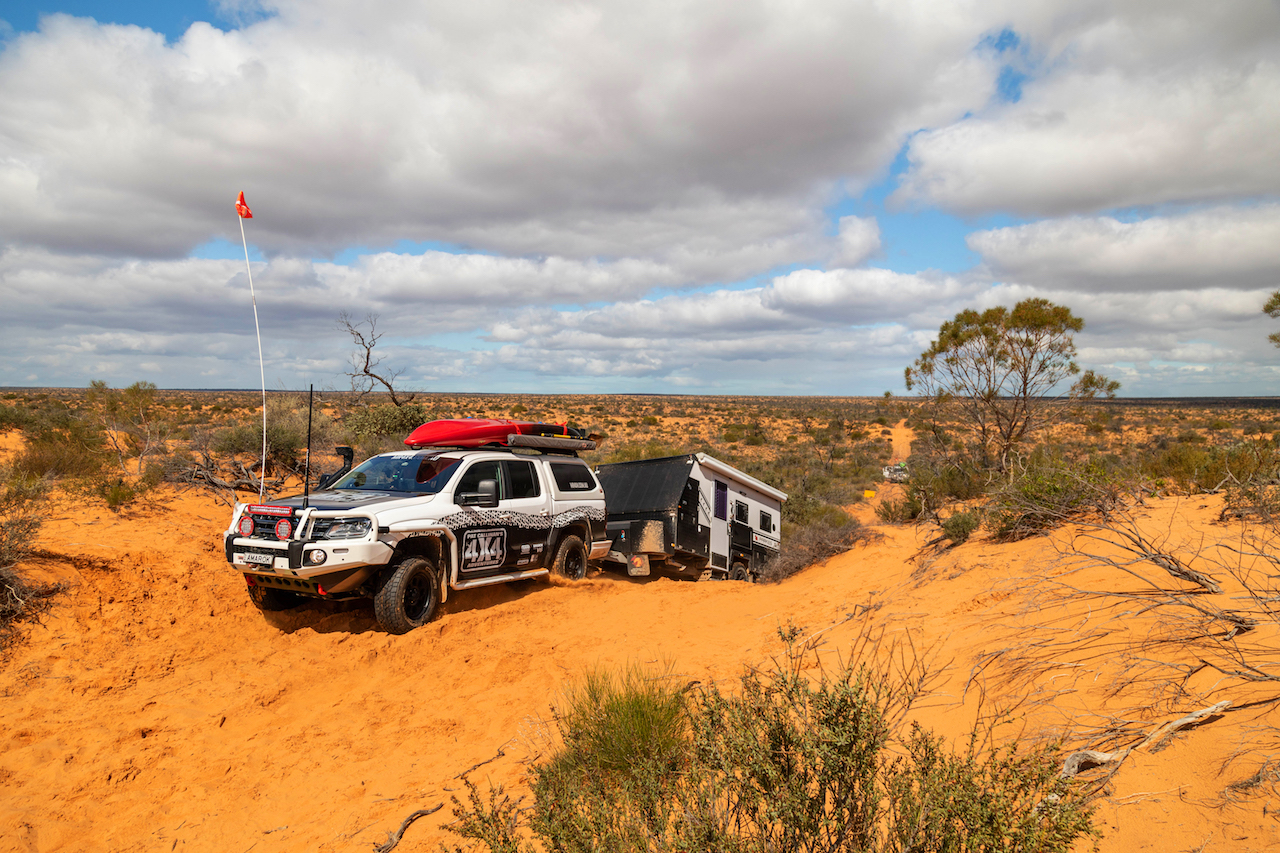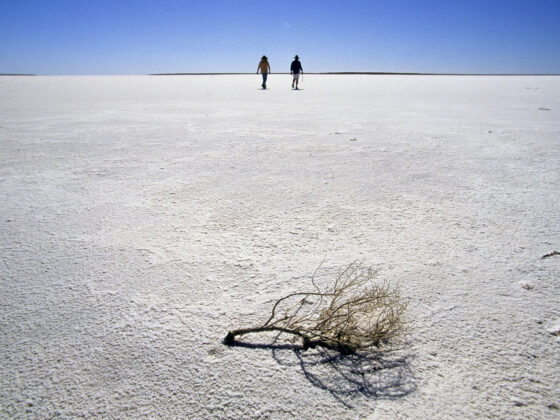Own a camper trailer and plan on heading into the outback or onto a beach? Here’s what you need to know about towing your camper trailer on sand, without getting bogged.
Words by Mark Allen: Most 4X4ers should have a fair idea of what tyre pressures to run on their vehicles while beach driving, but there’s not a lot written about the poor old camper trailer tyre pressures to help prevent them acting like a big ol’ anchor. Not adjusting correctly, will see you bogged sooner rather than later, regardless of how much oomph your 4X4 may have.
Here’s a beaut way to get you started, but keep in mind you’ll need to compensate accordingly for your individual vehicle, trailer and loads.
- Lower your 4X4’s tyre pressures to the required pressures while parked on a hard surface; let’s say you usually run 18psi in soft sand;
- Measure the length of the tyre tread touching the ground at 18psi – don’t drive anywhere, just lower and measure. To make it easier, run two lines out from the tyre and measure between them;
- Now, still while parked on flat hard ground, slowly lower your trailer’s tyre pressures until you achieve the same measured length in step two above; and
- Record that pressure and bingo, you’ve got a great starting point to pressure for your trailer.
As your trailer’s load varies, you’ll have to alter pressures, just like you should with your tow vehicle.
Note that the pressure in your 4WD will not be the same as the pressure in your trailer’s tyres, so make sure you record it, or if you’ve got a better memory than me, log it into your brain somewhere.
These lower pressures are only for off-road use, same as your tow vehicle, and need to inflate up to on-road pressures when you hit the hard top. You do carry a decent 12-volt air compressor and tyre pressure gauge, don’t you?
If you are having a camper trailer custom built, make sure you have the wheel track (from the left-hand side to the right) equal to your tow vehicle’s wheel track. This allows your camper’s wheels to roll in the same tracks your vehicle has created, saving a considerable amount of drag instead of having to plough another set.
While it depends on the beach conditions, and no two beaches are the same, if you should start to ‘bog down’ in the soft stuff, if you have room and if the beach conditions allow, steer downhill (towards the waterfront) to firmer, more compact sand. Keep accelerating, without wheel spin, to keep momentum ensuring you don’t come to a total stop in the soft sand. Don’t get too close to the water and ensure you know the tides. As much as possible, beach driving should be restricted to low tide or a few hours either side.
Knowing your vehicle is paramount; power band, gearing, rev limits and your ability to quickly react to make small changes makes a huge difference to your overall momentum. While momentum is your friend, don’t go at it like a bull-at-a-gate and hit enormous speeds. Ignore this and sooner or later you’ll damage something when you hit a depression or ridge in the sand. So, keep speeds sensible, stay in the correct gear to allow plenty of engine torque and learn to ‘read’ the terrain ahead, while avoiding the deepest, softest sand if you can.
Long stints of soft sand driving puts massive strains on your engine, driveline and cooling system, so keep a close eye on your vehicle’s temperature gauge. Depending on your vehicle’s engine and gearbox, try not to let engine revs drop too much as low revs in high gears exacerbates loads transferred into gearbox and transfer cases. Accept the fact that you’re going to use more fuel while towing on sand (petrol engines more so than diesel) so don’t be scared to keep revs in a useful range should a soft patch sneak up on you, even if that means keeping them higher than usual.
If forward motion stops … that’s a fancy term for getting bogged… back off the go-pedal straight away to prevent digging yourself deeper, making recovery even harder.
Assess the situation, get your long-handled shovel out … you packed that, didn’t you? Start digging and employ whatever sand recovery skills you may have learnt … you did learn them before you left home, right?
Why are we adjusting our trailer’s tyre pressures? I mean, they don’t apply drive and they don’t provide traction while powering forward, so why bother? Easy – flotation.
The more you can keep both your tow vehicle and trailer floating on, or riding on top of the sand, instead of being dragged through it, the easier it is for your tow vehicle to lug that anchor, I mean trailer, to your next campsite. Unfortunately, no matter how competent a driver you are, how much power and torque your 4X4 has, sooner or later you will get bogged if you’re towing anything, camper, box or even caravan, in the sand. But, if you’ve set tyre pressures of both your tow vehicle and trailer accordingly, it’ll be far less frequent.
This article was originally published in Pat Callinan’s 4X4 Adventures Issue 41.














